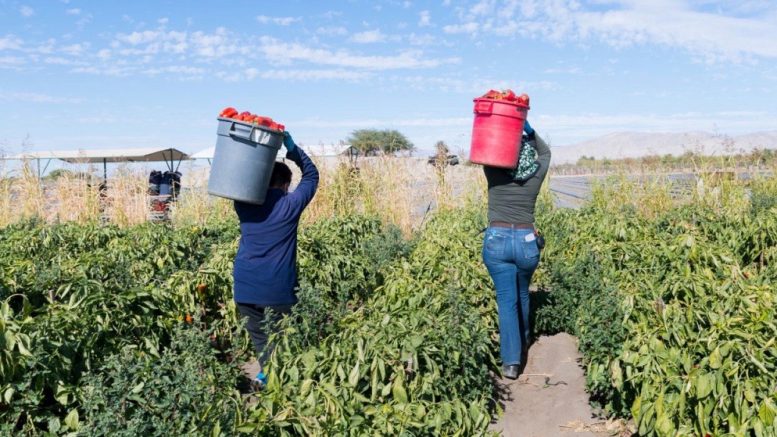By Miranda Green and Heidi de Marco for California Healthline
Leoncio Antonio Trejo Galdamez, 58, died in his son’s arms on June 29 after spending the day laying irrigation pipes in the Coachella Valley. News of his death reverberated through the largely Latino community near the Mexican and Arizona borders — another casualty in a dangerous business.
“Farmworkers are at the front lines of climate change. And, in some instances, we’re seeing a perfect storm battering our workers: covid-19, wildfire smoke and heat,” said Leydy Rangel, a spokesperson for the United Farm Workers Foundation.
For workers like Trejo Galdamez, whose jobs depend on outdoor work, a few degrees can mean the difference between life and death. Farmworkers here wear long shirts, thick jeans, heavy boots and wide-brimmed hats to guard against the heat. Even so, ambulances are frequently called to the fields, and heat-related illness appears to be increasing in the area.
“The heat feels awful,” said Jaime Isidoro, 36. “You start to work, you start to sweat, and the shirt underneath gets drenched.”
Born in Puebla, Mexico, Isidoro has been picking crops for two decades in the Coachella Valley. The region has one of the country’s longest growing seasons, providing most of America’s winter vegetables. It’s also home to hundreds of date farms, fruits that thrive in the hot, dry climate.
Heat is a given here.
“A few years ago, my head started hurting. I started to get chills. I went to the clinic and they gave me a couple of shots,” said Isidoro. “They told me it was a heatstroke. You don’t know the symptoms. I didn’t know it was that until I had it.”
And the temperatures are getting more extreme.
On Aug. 4, three of the desert communities in the region surpassed their daily recorded highs, hitting 122 degrees Fahrenheit in Palm Springs and Thermal, and 120 in Indio. Thermal set a record for its hottest temperature ever for August at 121 degrees. California registered its hottest June and July.
Heat is the leading weather-related cause of death in the United States. Heat stress killed 815 U.S. workers and seriously injured more than 70,000 workers from 1992 through 2017, according to the Bureau of Labor Statistics. In California, heat-related emergency room visits increased by 35% from 2005 to 2015, the latest year for which data was readily available, with disproportionate increases among Black, Latino and Asian American communities.
Medical staffers in the Coachella Valley say they’ve treated a rising number of patients suffering from heat exhaustion or heatstroke in recent years. California in 2018 saw 6,152 emergency room visits due to heat-related illness. Riverside County, which includes Coachella, Indio and Palm Springs, has among the highest rates of heat-related ER visits in the state.
“If we start seeing above 120 degrees in any regular capacity, we’re really in uncharted territory. The human body is not designed to exist in that kind of heat,” said Dr. Andrew Kassinove, emergency department physician and chief of staff at JFK Memorial Hospital in Indio.
The hospital regularly treats people who work outside for heat exhaustion, characterized by nausea, lightheadedness, fatigue, muscle cramping and dizziness. Less frequently they see heatstroke, a more dangerous condition whose symptoms include headache, confusion, vomiting, rapid heart rate, fainting and a failure to sweat.
JFK Memorial has treated 129 heat-related cases already this year, compared with 85 during the same period in 2020 and 75 in 2019, said hospital spokesperson Todd Burke.
“Core body temperatures that are really elevated require lifesaving measures to treat them,” Kassinove said. As temperatures rise above the typical human temperature of 98.6 degrees Fahrenheit, the body struggles to dissipate the heat.
California has some of the strictest worker protections for heat exhaustion. A standardadopted by occupational safety officials in 2006 was the first in the country to apply to all outdoor jobs, mandating companies to provide workers with adequate shade, downtime and water. After a historic heat wave hit the Pacific Northwest this June, Oregon and Washington adopted similar protections. Some members of Congress have introduced a similar bill and want the Labor Department to establish federal standards.


Why would you say the Coachella Valley is a “largely Latino community near the Mexican and Arizona borders?”. That’s just weird.